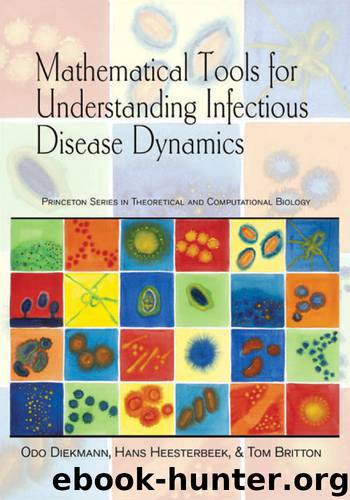Mathematical Tools for Understanding Infectious Disease Dynamics by Diekmann Odo; Heesterbeek Hans; Britton Tom

Author:Diekmann, Odo; Heesterbeek, Hans; Britton, Tom
Language: eng
Format: epub
Publisher: Princeton University Press
These two equations can be simplified to one equation for one unknown by defining a new variable y = αsπsxs + αcπcxc.
iii) Compute and the overall fraction infected for the three cases treated above.
1The function sign is defined in the usual way: sign (y) = y/|y|if y ≠ 0, and sign (0) = 0.
2See e.g., H. Inaba: Threshold and stability results for an age-structured epidemic model. J. Math. Biol, 28 (1990), 411–434; H.J.A.M. Heijmans: The dynamical behaviour of the age-size distribution of a cell population. In: J.A.J. Metz and O. Diekmann (1986), pp. 185–202. H.R. Thieme: Spectral bound and reproduction number for infinite-dimensional population structure and time heterogeneity. SIAM J. Appl. Math., 70 (2009), 188–211.
3O. Diekmann, S.A. van Gils, S.M. Verduyn Lunel and H.-O. Walther: Delay Equations: Functional-, Complex-, and Nonlinear Analysis. Springer-Verlag, Berlin, 1995; G. Gripenberg, S-O. Londen and O. Staffans: Volterra Integral and Functional Equations. Cambridge University Press, Cambridge, 1990; O. Diekmann, P. Getto and M. Gyllenberg: Stability and bifurcation analysis of Volterra functional equations in the light of suns and stars. SIAM J. Math. Anal., 39 (2007), 1023–1069.
4The proof is based on ideas in C.K. Li and H. Schneider: Applications of Perron-Probenius theory to population dynamics. J. Math. Biol., 44 (2002), 450–462, who addressed a similar problem in population dynamics in a discrete-time setting — building, in turn, on ideas in J.M. Cushing and Zhou Yicang: The net reproductive value and stability in matrix population models. Nat. Res. Mod., 8 (1994), 297–333. In P. Van den Driessche and J. Watmough: Reproduction numbers and sub-threshold endemic equilibria for compartmental models of disease transmission. Math. Biosci., 180 (2002), 29–48, a proof is presented in terms of M-matrices, and we refer to H.R. Thieme: Spectral bound and reproduction number for infinite-dimensional population structure and time heterogeneity. SIAM J. Appl. Math., 70 (2009), 188–211, for the analogous result for the infinite dimensional case.
5 A. Nold: Heterogeneity in disease-transmission modeling. Math. Biosci., 52 (1980), 227–240.
6 See e.g., R.D. Nussbaum: The Fixed Point Index and Some Applications. Séminaire de Mathématiques Supérieures. les Presses de l’Université de Montreal, Canada, 1985.
Download
This site does not store any files on its server. We only index and link to content provided by other sites. Please contact the content providers to delete copyright contents if any and email us, we'll remove relevant links or contents immediately.
| Administration & Medicine Economics | Allied Health Professions |
| Basic Sciences | Dentistry |
| History | Medical Informatics |
| Medicine | Nursing |
| Pharmacology | Psychology |
| Research | Veterinary Medicine |
Good by S. Walden(3488)
The Social Psychology of Inequality by Unknown(2940)
0041152001443424520 .pdf by Unknown(2784)
The Checklist Manifesto by Atul Gawande(2779)
The Meaning of the Library by unknow(2505)
Guns, Germs and Steel by Diamond Jared(2303)
Borders by unknow(2229)
23:27 by H. L. Roberts(2197)
And the Band Played On by Randy Shilts(2129)
Get What's Yours for Medicare: Maximize Your Coverage, Minimize Your Costs by Philip Moeller(2099)
Being Mortal: Medicine and What Matters in the End by Atul Gawande(2086)
A Leg to Stand On by Oliver Sacks(2005)
The Hot Zone by Richard Preston(1983)
The Valachi Papers by Peter Maas(1815)
The Laws of Medicine by Siddhartha Mukherjee(1756)
The Andromeda Strain by Michael Crichton(1696)
The Obesity Epidemic by Robyn Toomath(1647)
Pharmacy Practice and The Law by Richard Abood(1543)
Autism's False Prophets by Paul A. Offit(1496)
